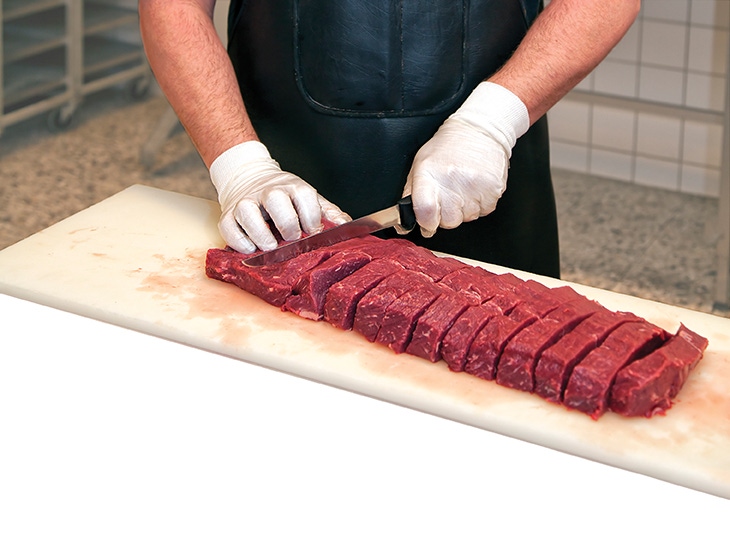New study sheds light on systems approach to veterinary practice.
October 27, 2013

The face of the food industry is changing. Modern food production and farming are not what they were decades ago.
Not only is that changing how producers approach their operations, but this also affects how beef practitioners approach their relationships with clients, and their diagnoses and treatments.
In a study in 2010, titled “Food Systems Veterinary Medicine for the 21st Century,” experts at Iowa State University (ISU) and Kansas State University (KSU) address this topic in hopes of developing ways to better prepare veterinarians for practice in a food systems world.
H. Scott Hurd, DVM, Ph.D., associate professor, College of Veterinary Medicine, ISU, and Bob L. Larson, DVM, Ph.D., professor, Coleman Chair Food Animal Production Medicine, Department of Clinical Sciences, College of Veterinary Medicine, KSU, are leading the program.
They say no matter a veterinarian’s specialty, he must understand the implications of decisions throughout the food, environment and public health systems. They say, this can best be accomplished by taking a “systems approach” to their practice.
Times, They Are A-Changin’
Dr. Hurd says traditional veterinary training has often involved a clinical approach, running through lists of diagnostic tests.

H. Scott Hurd, DVM, Ph.D., College of Veterinary Medicine, ISU
“It’s more of an ‘if this, then that’ approach,” he says. “But if a veterinarian finds himself working in a large, integrated feedyard or packing plant, or in Washington D.C. dealing with policy, that sort of problem solving isn’t sufficient.”
When working in food system environments, Dr. Hurd says, a system approach (like that used in engineering) is more appropriate and effective.
“Rarely is a veterinarian dealing with one individual animal,” he says. “Veterinarians are typically working within an ecosystem. People, feed and wildlife find themselves going in and out of this dynamic ecosystem.”
Dr. Larson says the traditional method of veterinary training includes reducing problems down to single or very few components—for example, a bacteria or virus that causes the disease.
“We tend to teach the pathogens that cause scours, respiratory disease or abortion,” he says. “In reality, a veterinarian is faced with the syndrome of scours, respiratory disease or abortion that involve much more than pathogens. We are attempting to redesign the teaching and learning process to take a step back and focus on the initial complaint, rather than the toxins or bacteria associated with it.”
This approach has led to veterinary students reaching the answer more quickly, Dr. Larson says.
“It forces efficiencies. You get the right answer more often and more quickly,” he says. “You spend less time and get the right diagnostic answers more quickly.”
In addition, Dr. Larson says, many causes of disease, or reproductive or growth inefficiency occurred in the past or in a distant location. A systems approach allows a practitioner to investigate the entire set of factors that contribute to a problem.
“When the root problem occurred weeks, months or years ago, you’ll be more effective by evaluating and diagnosing the problem by looking at the entire system, rather than the problem you face today,” he says. “Many times, successful treatment is tied to applying the remedy to the right place—to go back to an early risk factor.”
Time for Training
Dr. Hurd and Dr. Larson say a systems approach can better equip veterinary students with dynamic problem solving techniques, and with skills for diagnosing, designing and correcting complex problems.
The challenge has become fitting the education into an already-full college course work. Dr. Hurd says the solution may be to incorporate the principles into already-existing classes.
“Our approach is to take the systems thinking and inject it into a specific piece of material they need to learn,” he explains. “For example, they can learn about bovine virus diarrhea at the same time of teaching the systems approach skills.”
That’s just what they’ve begun to do. Through this project, the team is assisting food animal faculty at ISU, KSU and the University of Arkansas in revising existing materials to incorporate the systems approach.

Bob L. Larson, DVM, Ph.D., College of Veterinary Medicine, KSU
Dr. Larson says he’s seeing positive results at KSU. By following a beef cattle ranch over a period of ten years, students are able to visualize the flow of animals as they enter the herd as heifers, become pregnant the first time, face the risk of being culled, and if not culled, continue in the herd through several breeding seasons.
Pinpointing bottlenecks in the system also became a key aspect of the study, Dr. Larson says.
“By following through the years, we could go back to bottlenecks and see areas of higher-than-expected death loss and abortions,” he says. “We then can discuss how to address those bottlenecks. We weren’t addressing individual pathogens causing the problems. Rather, we taught syndromes and helped students work through the case studies presented to them.”
By taking a step back and evaluating the system from a distance, Dr. Larson says, problems can be identified more easily.
“If we have too many open two-year-olds, the problem can often be traced back to their very first breeding season, and whether they were bred early or late,” he says. “If they were bred early, they’re much less likely to be open a year later when they’re two.” We find with students, it is easier for them to recognize the cause and effect when they are close in time and space. However, when separated by time and space, it’s more difficult to see.”
Students have been accepting and appreciative of the approach, Dr. Larson says.
“They have taken numerous classes on virology, bacteriology, pharmacology and pathology,” he says. “By using the overarching systems method of diagnosing problems and selecting the best interventions, it brings all of these classes together. Utimately, the students are better able to put these ideas into practice in the real world.”
Dr. Hurd says industry response has been overwhelmingly positive, as well.
“I’ve gotten remarkably positive responses from the cattle industry and other veterinarians,” he says. “Veterinarians already working in the system say, ‘If only I’d known this before I got out of veterinary school.’”
Taking the systems approach to veterinary practice can provide great benefits to the cattle industry, as a whole, Dr. Larson says.
Subscribe now to Cow-Calf Weekly to get the latest industry research and information in your inbox every Friday!
“When we set up an effective health system, the farm runs more smoothly,” he says. “We are thinking through multiple years, multiple animals and multiple situations. It also helps improve the communication between owners and veterinarians involved in various segments of the industry. A systems approach provides a common language to best solve problems throughout the many segments of the industry. If we’re going to be successful, we must have very good communication.”
Dr. Hurd says this mentality can benefit individual veterinary practices, as well.
“It’s essentially a problem solving technique that can be adapted to many situations,” he says. “It would be interesting to apply to interpersonal relationships, as well. Whether it’s big industry or small, it’s a problem solving approach. Everyone has plenty of problems to solve.”
Get in the Know
Moving forward, Dr. Larson says, the team plans to incorporate these concepts into current veterinary education, including potential textbooks, presentations at beef and swine practitioner meetings, and short courses.
“We are starting to include these concepts into the veterinary continuing education training we already provide,” he says.
Continued evolution of the program is also inevitable, Dr. Larson says.
“I have learned about these systems by studying engineering systems, and by watching veterinarians successfully implementing the concepts,” he says. “I have learned a lot from those practitioners who I believe are doing it well, and now I’m trying to teach students what I’ve seen successful systems thinkers do. It’s a evolutionary process for me, as well.”
You might also like:
Cattle Prepared For The Feedlot Simply Perform Better
BEEF Honors 50 Top Industry Leaders
Cow Fixer Vs. Herd Health Veterinarian? BEEF Vet Examines Production
65 Photos That Celebrate Cowgirls & Cattlewomen
Sustaining A Rural Practice Requires An Understanding Of Rural Lifestyle
You May Also Like



